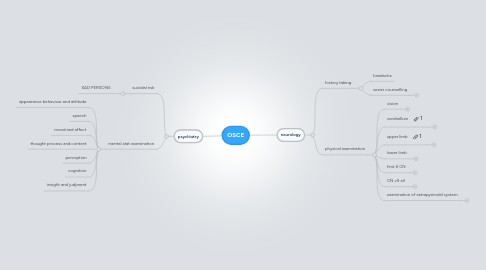
1. psychiatry
1.1. suicidal risk
1.1.1. SAD PERSONS
1.2. mental stat examination
1.2.1. appearance behaviour and attitude
1.2.2. speech
1.2.3. mood and affect
1.2.4. thought process and content
1.2.5. perception
1.2.6. cognition
1.2.7. insight and judjment
2. neurology
2.1. history taking
2.1.1. headache
2.1.2. sezier counselling
2.1.2.1. sport
2.1.2.1.1. swimming in controlled supervision in swimming pool
2.1.2.1.2. cycling is gd if controlled sezier wear helmet
2.1.2.2. marrigae
2.1.2.2.1. FINE BUT NEED TO BE EXPRESSED AND KNOWN
2.1.2.3. pregnancy
2.1.2.3.1. some epileptic medication reduce oral contraceptive
2.1.2.3.2. don't get pregnant before telling gut doctor
2.1.2.4. jop
2.1.2.5. driving
2.1.2.5.1. need permission depend
2.1.2.6. other
2.1.2.6.1. photo sensitivy
2.1.2.6.2. lack of sleep induce
2.2. physical examination
2.2.1. vision
2.2.1.1. inspection
2.2.1.1.1. in front and above
2.2.1.2. vision acuity
2.2.1.2.1. snellen chart
2.2.1.2.2. shrt dis
2.2.1.3. visual field
2.2.1.3.1. confrontation test
2.2.1.3.2. test both the one by one
2.2.1.3.3. moving the finger
2.2.1.4. central blind spot
2.2.1.4.1. with a red point stick
2.2.1.5. eye muscles movement
2.2.1.5.1. moving like and H shape
2.2.1.6. inspect the pupil
2.2.1.6.1. cover test
2.2.1.7. pupiliry reflex
2.2.1.7.1. tourch
2.2.1.8. accommodation
2.2.1.9. fundoscope
2.2.1.10. geeky
2.2.1.11. MC
2.2.2. cerebellum
2.2.2.1. gait
2.2.2.1.1. walking
2.2.2.1.2. heel to teo
2.2.2.1.3. runberg test
2.2.2.2. vision
2.2.2.2.1. nystugmus
2.2.2.3. speech
2.2.2.3.1. repeat three sentences
2.2.2.4. muscles
2.2.2.4.1. tone of the upper arm
2.2.2.4.2. resting tremor
2.2.2.5. dysdiadokineasia
2.2.2.6. finger- nose test
2.2.2.6.1. intention tremor
2.2.2.7. fine finger movment
2.2.2.8. rebound
2.2.2.9. lower leg
2.2.2.9.1. tone
2.2.2.9.2. heel to chin
2.2.3. upper limb
2.2.3.1. motor
2.2.3.1.1. inspection
2.2.3.1.2. tone
2.2.3.1.3. power
2.2.3.1.4. finger nose and dysdiadochinesia
2.2.3.1.5. rebound
2.2.3.1.6. hofmman
2.2.3.1.7. reflexes if u want
2.2.3.2. sensory
2.2.3.2.1. soft touch by cotton alldermatomos
2.2.3.2.2. SHOW THE EXAMINER THAT YOU KNOW THE DERMATOMES
2.2.3.2.3. sharp-dull all deramt
2.2.3.2.4. TELL THE EXAMINER 128 MHZ IS THE APPROPRIATE ONE
2.2.3.2.5. vibration
2.2.3.2.6. finger sense of position
2.2.3.2.7. coordination and proproception
2.2.3.2.8. finger nose and dysdiadochinesia
2.2.3.2.9. Indicates need to carry out full neurological examination
2.2.4. lower limb
2.2.4.1. motor
2.2.4.1.1. inspection
2.2.4.1.2. tone
2.2.4.1.3. clonus
2.2.4.1.4. power
2.2.4.1.5. babnski
2.2.4.1.6. heel to shin
2.2.4.2. sensory
2.2.4.2.1. light touch
2.2.4.2.2. sharp
2.2.4.2.3. vibratioon
2.2.4.2.4. SHOW THE EXAMINER THAT YOU KNOW THE DERMATOMES
2.2.4.2.5. joint sense
2.2.4.2.6. gait
2.2.5. first 6 CN
2.2.5.1. olfactory
2.2.5.1.1. if there is problem
2.2.5.1.2. test each nostril which district smell
2.2.5.2. 2.3.4.6
2.2.5.2.1. as visuial
2.2.5.3. trigeminal
2.2.5.3.1. motor
2.2.5.3.2. sensor
2.2.5.3.3. corneal reflex
2.2.5.3.4. jaw reflex
2.2.6. CN vII-xII
2.2.6.1. VII
2.2.6.1.1. inspection
2.2.6.1.2. power
2.2.6.2. VIII
2.2.6.2.1. whisper test
2.2.6.2.2. renin test
2.2.6.2.3. wheber
2.2.6.3. IX,X,XII
2.2.6.3.1. cough
2.2.6.3.2. palato uvula say aaaa
2.2.6.3.3. blow cheeck
2.2.6.3.4. inspect and palpate sternoclmastiod
2.2.6.3.5. power
2.2.6.3.6. inspect and palpate the trapezius
2.2.6.3.7. power
2.2.6.3.8. X!!
2.2.7. examination of extrapyrimdal system
2.2.7.1. inspection
2.2.7.1.1. while sitting on chair
2.2.7.1.2. loss of facial expression
2.2.7.1.3. hypophonia
2.2.7.1.4. hypomimia
2.2.7.1.5. poor eye contact
2.2.7.1.6. micro graphia
2.2.7.1.7. sebrrhia
2.2.7.1.8. silrrhea
2.2.7.2. tremor
2.2.7.2.1. abduction of shoulder with flexion of are will exacerbate
2.2.7.2.2. or ask him to count backward from ten
2.2.7.3. tone
2.2.7.3.1. rigidity, spasticity
2.2.7.4. bradykinesia
2.2.7.4.1. opening and closing of the fest fastly
2.2.7.4.2. foot movment
2.2.7.4.3. or thumb and index
2.2.7.5. gait
2.2.7.5.1. arm swing
2.2.7.5.2. shuffling
2.2.7.5.3. turned back in many steps
2.2.7.5.4. short steps
2.2.7.5.5. postual stability
